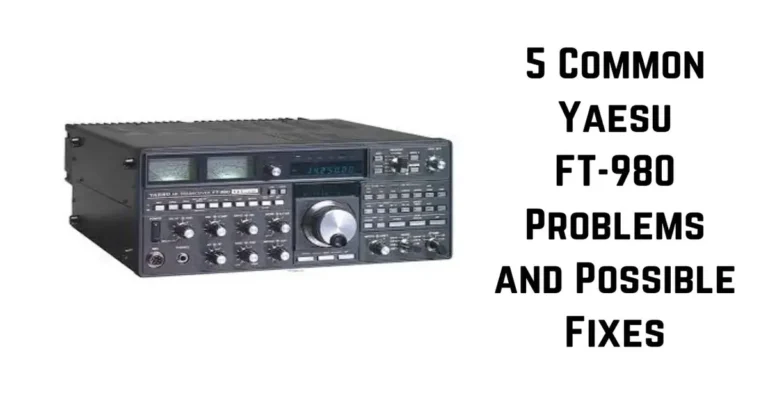5 Common Yaesu FT-450 Problems and Possible Fixes
The Yaesu FT-450 is a popular HF/6M transceiver favored by amateur radio operators worldwide. Its affordability, combined with an impressive array of features, makes it a go-to choice for those seeking a reliable piece of equipment. The FT-450 offers excellent performance in a compact form, making it ideal for both portable and fixed-station setups. However, like any complex electronic device, the FT-450 is not without its issues. Even with its robust design, users have reported encountering a few common problems that can hinder its performance.
Understanding these issues and knowing how to address them can save operators time and frustration, ensuring their transceiver remains in top working condition. In this blog post, we’ll explore five common problems that users face with the Yaesu FT-450 and provide practical solutions to keep your transceiver performing at its best.
Problem 1: Audio Distortion Issues
Description:
One of the most frequently reported issues with the Yaesu FT-450 is audio distortion, particularly on transmitted signals. Users may notice that their audio sounds unclear, muffled, or distorted when they are transmitting, which can lead to poor communication quality. This issue is often more noticeable when using certain microphones or in specific operating conditions.
Possible Causes:
- Incorrect Microphone Settings: The microphone gain setting on the FT-450 might be too high or too low, causing the audio to clip or become distorted. Additionally, incorrect settings on the equalizer can exacerbate this problem.
- External Interference: Interference from nearby electronic devices or poor shielding can introduce noise into the audio chain, leading to distortion.
- Faulty Connections: Loose or corroded connectors between the microphone and the transceiver can cause intermittent audio issues, leading to distortion.
Solutions:
- Adjust Microphone Gain: Start by adjusting the microphone gain according to the user manual’s recommendations. It’s crucial to set the gain so that the ALC (Automatic Level Control) meter moves slightly when speaking at a normal level without exceeding the recommended range.
- Use an External Audio Filter: If external interference is suspected, using an external audio filter can help clean up the signal, reducing or eliminating distortion.
- Inspect and Secure Connections: Regularly inspect the microphone cable and connections for signs of wear or corrosion. Replacing worn cables or cleaning connectors can resolve many audio issues.
Read More: 6 Common Yaesu SM-5000 Problems and Possible Fixes
Problem 2: Frequency Drift
Description: Frequency drift is another issue that some Yaesu FT-450 users experience, particularly during extended periods of operation. This issue can manifest as a gradual shift in the operating frequency, which can lead to problems in maintaining a stable connection, especially during long QSOs (conversations).
Possible Causes:
- Temperature Instability: The internal components of the FT-450, particularly the oscillators, can be sensitive to temperature changes. As the device heats up during operation, the frequency may drift.
- Aging Components: Over time, components such as capacitors and resistors may degrade, leading to instability in the frequency control circuits.
Solutions:
- Use an External Frequency Stabilizer: To counteract temperature-related drift, consider using an external frequency stabilizer or reference oscillator. These devices help maintain a stable frequency even as the internal temperature of the transceiver changes.
- Allow Warm-Up Time: Allow the FT-450 to warm up for several minutes before use. This practice helps stabilize the internal temperature, reducing the likelihood of frequency drift.
- Professional Calibration: If frequency drift continues to be an issue, it may be necessary to have the transceiver professionally calibrated. A technician can adjust or replace aging components that may be contributing to the instability.
Read More: 5 Common Yaesu Ft-1000MP Mark V Problems and Possible Fixes
Problem 3: Receiver Sensitivity Drops
Description:
A reduction in receiver sensitivity is a concern that can significantly impact the performance of the Yaesu FT-450. This problem manifests as weaker signal reception, making it difficult to pick up distant or low-power signals. Operators may notice that signals that were once clear are now faint or lost altogether.
Possible Causes:
- Aging RF Components: Over time, the components in the RF (radio frequency) section of the transceiver, such as transistors and capacitors, may degrade, leading to reduced sensitivity.
- External Interference or Obstructions: External factors, such as nearby buildings, trees, or electronic devices, can cause interference or block signals, reducing receiver sensitivity.
- Antenna Matching Issues: If the antenna is not properly matched to the transceiver, it can lead to poor reception and reduced sensitivity.
Solutions:
- Inspect Antenna System: Begin by inspecting the entire antenna system, including the feedline and connectors, for any signs of damage or wear. Ensure that the antenna is properly matched to the transceiver using a good-quality antenna tuner if necessary.
- Replace Aging Components: If the issue persists, consider having the RF section checked by a qualified technician. Replacing aging or faulty components can restore the transceiver’s sensitivity to its original levels.
- Experiment with Antenna Placement: If external interference is suspected, try relocating the antenna to a higher or more open location. This can improve signal reception and reduce the impact of obstructions.
Read More: Most Common Yaesu MD-100 Problems and Possible Fixes
Problem 4: Display or Screen Issues
Description:
Display issues are another common problem reported by Yaesu FT-450 users. These issues can range from dimming or flickering to complete failure of the display. A malfunctioning display can make it difficult to read frequencies, settings, and other critical information, hindering the operation of the transceiver.
Possible Causes:
- Aging Backlight Components: The backlight that illuminates the display may degrade over time, leading to dimming or flickering.
- Connection Issues: Loose or corroded connections between the display and the main board can cause intermittent or complete display failures.
- Power Supply Problems: An unstable or incorrect power supply can also cause display issues, particularly flickering or dimming.
Solutions:
- Inspect and Clean Connections: Begin by inspecting the connections between the display and the main board. If corrosion or looseness is found, clean and secure the connections. This simple step can often resolve display issues.
- Replace Backlight or Screen: If the backlight has failed, it may need to be replaced. In some cases, replacing the entire display unit may be necessary. This should be done by a professional unless you are experienced with electronics repair.
- Check Power Supply: Ensure that the power supply to the transceiver is stable and within the correct voltage range. If the power supply is fluctuating, it could be causing display issues. Replacing or repairing the power supply may be necessary.
Read More: Yaesu Vr-5000 Display Problems and Possible Fixes
Problem 5: Power Output Fluctuations
Description:
Inconsistent power output is a problem that can affect the performance of the Yaesu FT-450, particularly when transmitting. Users may notice that the power output does not match the settings, with unexpected drops or surges in power. This can lead to weak transmissions or even potential damage to the transceiver.
Possible Causes:
- Poor Power Supply or Grounding Issues: An unstable power supply or poor grounding can cause fluctuations in power output, leading to inconsistent performance.
- Faulty Internal Components: Components such as capacitors, transistors, or voltage regulators within the transceiver can fail over time, causing power output issues.
- Incorrect Settings: In some cases, incorrect settings in the transceiver’s menu or external equipment can cause power fluctuations.
Solutions:
- Check Power and Ground Connections: Begin by thoroughly inspecting all power and ground connections to ensure they are secure and free of corrosion. Poor connections can cause voltage drops, leading to power fluctuations.
- Test Power Supply Under Load: Use a multimeter to test the power supply under load conditions. Ensure that it is delivering a stable voltage that meets the transceiver’s specifications. Replace the power supply if necessary.
- Replace Faulty Components: If internal components are suspected to be the cause, it may be necessary to replace them. This is typically a job for a qualified technician, as it involves diagnosing and repairing the transceiver’s internal circuitry.
Read More: Yaesu Ft-1000mp Display Problems and Possible Fixes
Conclusion
The Yaesu FT-450 is a reliable transceiver, but like any electronic device, it can encounter issues over time. By understanding common problems such as audio distortion, frequency drift, receiver sensitivity drops, display issues, and power output fluctuations, operators can take proactive steps to maintain their equipment. Regular maintenance, proper setup, and timely repairs are key to ensuring that the FT-450 continues to perform optimally.
While some issues can be resolved with simple adjustments or DIY fixes, others may require professional attention. Staying informed and vigilant can help you avoid costly repairs and extend the life of your transceiver. With the right care, the Yaesu FT-450 will remain a valuable tool in your amateur radio setup for years to come.






